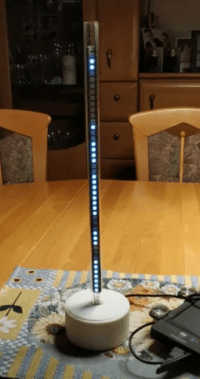What is the time, now

from the largest decimal time scale in the world (according to the Guinness book of records) to a desktop project
I only started collecting my first experiences with this new hobby in 2018. I decided to enter my retirement and suddenly had a wealth of time. My first action was a 400 pages book on the Raspberry Pi 2. I remembered the equation V= i*R from school (in Germany, this is known as U = R * I, strangely enough). Furthermore I have no engineering background.
In order to understand this formula, you will need to step into the matter and do something. But, my personal goal is the KISS principle, Keep It Simple (and) Stupid. So I started off by lighting up one LED, then several LEDs by following scripts from the web.In the meantime, I have finished more complicated projects, such as a digital clock similar to the Düsseldorf Rheinturm (https://de.wikipedia.org/wiki/Lichtzeitpegel), the largest decimal clock in the world (according to the Düsseldorf city guide. I learned a lot reading the documentation from HJBerndt (Homepage von H.-J. Berndt (hjberndt.de) in german language). Ever since I have built several versions, but my final one is a desktop unit, which switches automatically between summer and winter time. (thanks to: Network Time Protocol (NTP), Timezone and Daylight saving time (DST) with esp8266, esp32 or Arduino – Renzo Mischianti)
Based on an ESP8266, which does not have a reliable RTC, I pick up the actual time from the NTP time signal via WiFi every 5,10 or whatever amount of minutes as you like. Please have a look at : https://drive.google.com/file/d/1-OdWS-6DkeiITuCHIhQFX394aW3Gj4s0/view?usp=sharing
Beside this appealing project, it became clear to me that you do not need the biggest, fastest CPU to achieve a goal. Check the web for mischianti.org and search there for "What do you want", where I have prepared a comparison between several ESP boards, Arduinos, Raspberries and even an STM32 board.
I look forward to hearing your comments
In order to understand this formula, you will need to step into the matter and do something. But, my personal goal is the KISS principle, Keep It Simple (and) Stupid. So I started off by lighting up one LED, then several LEDs by following scripts from the web.In the meantime, I have finished more complicated projects, such as a digital clock similar to the Düsseldorf Rheinturm (https://de.wikipedia.org/wiki/Lichtzeitpegel), the largest decimal clock in the world (according to the Düsseldorf city guide. I learned a lot reading the documentation from HJBerndt (Homepage von H.-J. Berndt (hjberndt.de) in german language). Ever since I have built several versions, but my final one is a desktop unit, which switches automatically between summer and winter time. (thanks to: Network Time Protocol (NTP), Timezone and Daylight saving time (DST) with esp8266, esp32 or Arduino – Renzo Mischianti)
Based on an ESP8266, which does not have a reliable RTC, I pick up the actual time from the NTP time signal via WiFi every 5,10 or whatever amount of minutes as you like. Please have a look at : https://drive.google.com/file/d/1-OdWS-6DkeiITuCHIhQFX394aW3Gj4s0/view?usp=sharing
Beside this appealing project, it became clear to me that you do not need the biggest, fastest CPU to achieve a goal. Check the web for mischianti.org and search there for "What do you want", where I have prepared a comparison between several ESP boards, Arduinos, Raspberries and even an STM32 board.
I look forward to hearing your comments



Discussion (1 comment)